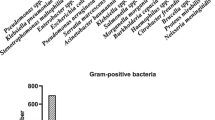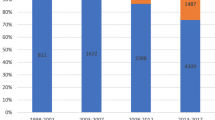Abstract
Objectives
This study aimed to investigate the microbiological profiles and antimicrobial resistance patterns of bloodstream pathogens in Chinese children.
Methods
This retrospective study was conducted at 13 tertiary hospitals in China during 2016–2018. The first bloodstream isolates of the same species from one pediatric patient < 18 years were included to this study for analysis. Antimicrobial susceptibility testing was determined based on minimum inhibitory concentrations or Kirby-Bauer disk diffusion methods according to the 2018 Clinical and Laboratory Standards Institute guidelines.
Results
Overall, 9345 nonduplicate bloodstream isolates were collected. Top 10 pathogens included Coagulase-negative staphylococcus (CoNS) (44.4%), Escherichia coli (10.2%), Klebsiella pneumoniae (5.9%), Staphylococcus aureus (5.0%), Streptococcus pneumoniae (4.9%), Pseudomonas aeruginosa(2.8%), Enterococcus faecium (2.7%), Stenotrophomonas maltophilia (2.4%), Salmonella spp. (2.3%), and Streptococcus agalactiae (2.0%). The commonest pathogens apart from CoNS in age group 0–28 days, 29 days–2 months, 3-11 months, 1–5 years, and ≥ 5 years were Escherichia coli (17.2%), Escherichia coli (14.0%), Escherichia coli (7.9%), Streptococcus pneumoniae (10.7%) ,and Staphylococcus aureus (13.6%), respectively. The overall prevalence of extended-spectrum β-lactamases-producing Enterobacteriaceae, carbapenem-resistant Klebsiella pneumoniae, carbapenem-resistant Acinetobacter baumannii, and carbapenem-resistant Pseudomonas aeruginosa were 41.4, 28.4, 31.7, and 5.6%, respectively. The overall prevalence of methicillin-resistant Staphylococcus aureus, penicillin-resistant Streptococcus pneumoniae and vancomycin-resistant Enterococcus was 38.1, 28.3, and 0.7%, respectively.
Conclusions
The major bacterial pathogens have differences in different age groups, ward types, and regions in Chinese children, and the commonest causing microorganism was the Escherichia coli, especially in neonates and infants. High prevalence of important resistant phenotypes is of a serious concern.

Similar content being viewed by others
References
Weiss SL, Fitzgerald JC, Pappachan J, Wheeler D, Jaramillo-Bustamante JC, Salloo A et al (2015) Global epidemiology of pediatric severe sepsis: the sepsis prevalence, outcomes, and therapies study. Am J Respir Crit Care Med 191(10):1147–1157
Aiken AM, Allegranzi B, Scott JA, Mehtar S, Pittet D, Grundmann H (2014) Antibiotic resistance needs global solutions. Lancet Infect Dis 14(7):550–551
Lai CC, Lee K, Xiao Y, Ahmad N, Veeraraghavan B, Thamlikitkul V et al High burden of antimicrobial drug resistance in Asia. J Glob Antimicrob Resist 2(3):141–147
Diekema DJ, Hsueh PR, Mendes RE, Pfaller MA, Rolston KV, Sader HS et al (2019) The Microbiology of Bloodstream Infection: 20-Year Trends from the SENTRY Antimicrobial Surveillance Program. Antimicrob Agents Chemother 63(7)
Tacconelli E, Carrara E, Savoldi A, Harbarth S, Mendelson M, Monnet DL et al (2018) Discovery, research, and development of new antibiotics: the WHO priority list of antibiotic-resistant bacteria and tuberculosis. Lancet Infect Dis 18(3):318–327
World Health Organization Expert Committees. World Health Organization Model List of Essential Medicines for Children 7th List 2019. https://www.who.int/medicines/publications/essentialmedicines/en/. Accessed 15 Apr 2020
Johnson AP, Davies J, Guy R, Abernethy J, Sheridan E, Pearson A et al (2012) Mandatory surveillance of methicillin-resistant Staphylococcus aureus (MRSA) bacteraemia in England: the first 10 years. J Antimicrob Chemother 67(4):802–809
National Health Commission of the People's Republic of China (2018) Status report on antimicrobial adminstration in the People's Republic of China. Beijing, China, p 2018
Chen S, Liu S, Yuan X, Mai H, Lin J, Wen F Etiology, drug sensitivity profiles and clinical outcome of bloodstream infections: A retrospective study of 784 pediatric patients with hematological and neoplastic diseases. Pediatr Hematol Oncol 36(8):482–493
Dong L, Zhang XY, Li CC, Li Z, Xia YQ (2017) Characteristics of epidemiology and antimicrobial resistance of gram-negative bacterial bloodstream infections in children. Zhonghua Er Ke Za Zhi 55(9):683–688
Li S, Guo L, Liu L, Dong F, Liu G (2016) Clinical features and antibiotic resistance of Escherichia coli bloodstream infections in children. Zhonghua Er Ke Za Zhi 54(2):150–153
Zhang F, Li Y, Lv Y, Zheng B, Xue F (2019) Bacterial susceptibility in bloodstream infections: Results from China Antimicrobial Resistance Surveillance Trial (CARST) Program, 2015-2016. J Glob Antimicrob Resist 17:276–282
World Health Organization (2020). Global Antimicrobial Resistance and Use Surveillance System (GLASS) Report. https://www.who.int/glass/resources/publications/GLASS_report_2020_launch_webinar_v_25May2020_FINAL.pdf?ua=1. Accessed 27 Sept 2020
Hu F, Guo Y, Yang Y, Zheng Y, Wu S, Jiang X et al (2019) Resistance reported from China antimicrobial surveillance network (CHINET) in 2018. Eur J Clin Microbiol Infect Dis 38(12):2275–2281
Esposito S, Principi N (2015) Impacts of the 13-Valent Pneumococcal Conjugate Vaccine in Children. J Immunol Res 2015:591580
Bielicki JA, Lundin R, Sharland M (2015) Antibiotic Resistance Prevalence in Routine Bloodstream Isolates from Children's Hospitals Varies Substantially from Adult Surveillance Data in Europe. Pediatr Infect Dis J 34(7):734–741
Droz N, Hsia Y, Ellis S, Dramowski A, Sharland M, Basmaci R (2019) Bacterial pathogens and resistance causing community acquired paediatric bloodstream infections in low- and middle-income countries: a systematic review and meta-analysis. Antimicrob Resist Infect Control 8:207
Dramowski A, Cotton MF, Rabie H, Whitelaw A (2015) Trends in paediatric bloodstream infections at a South African referral hospital. BMC Pediatr 15:33
Maham S, Fallah F, Gholinejad Z, Seifi A, Hoseini-Alfatemi SM (2018) Bacterial etiology and antibiotic resistance pattern of pediatric bloodstream infections: A multicenter based study in Tehran, Iran. Ann Ig 30(4):337–345
Obeng-Nkrumah N, Labi AK, Addison NO, Labi JE, Awuah-Mensah G (2016) Trends in paediatric and adult bloodstream infections at a Ghanaian referral hospital: a retrospective study. Ann Clin Microbiol Antimicrob 15(1):49
Spaulding AB, Watson D, Dreyfus J, Heaton P, Grapentine S, Bendel-Stenzel E et al (2019) Epidemiology of Bloodstream Infections in Hospitalized Children in the United States, 2009-2016. Clin Infect Dis 69(6):995–1002
Cailes B, Kortsalioudaki C, Buttery J, Pattnayak S, Greenough A, Matthes J et al (2018) Epidemiology of UK neonatal infections: the neonIN infection surveillance network. Arch Dis Child Fetal Neonatal Ed 103(6):F547–F553
Chou CH, Lai YR, Chi CY, Ho MW, Chen CL, Liao WC et al (2020) Long-Term Surveillance of Antibiotic Prescriptions and the Prevalence of Antimicrobial Resistance in Non-Fermenting Gram-Negative Bacilli. Microorganisms. 8(3)
Olesen SW, Barnett ML, MacFadden DR, Brownstein JS, Hernández-Díaz S, Lipsitch M et al (2018) The distribution of antibiotic use and its association with antibiotic resistance. Elife.:7
Tammer I, Geginat G, Lange S, Kropf S, Lodes U, Schlüter D et al (2016) Antibiotic Consumption and the Development of Antibiotic Resistance in Surgical Units. Zentralbl Chir 141(1):53–61
Carrara E, Pfeffer I, Zusman O, Leibovici L, Paul M (2018) Determinants of inappropriate empirical antibiotic treatment: systematic review and meta-analysis. Int J Antimicrob Agents 51(4):548–553
Tacconelli E, Cataldo MA, Mutters NT, Carrara E, Bartoloni A, Raglio A et al (2019) Role of place of acquisition and inappropriate empirical antibiotic therapy on the outcome of extended-spectrum β-lactamase-producing Enterobacteriaceae infections. Int J Antimicrob Agents 54(1):49–54
Yang CJ, Chung YC, Chen TC, Chang HL, Tsai YM, Huang MS et al (2013) The impact of inappropriate antibiotics on bacteremia patients in a community hospital in Taiwan: an emphasis on the impact of referral information for cases from a hospital affiliated nursing home. BMC Infect Dis 13:500
Nabarro L, Shankar C, Pragasam AK, Mathew G, Jeyaseelan V, Veeraraghavan B et al (2017) Clinical and Bacterial Risk Factors for Mortality in Children With Carbapenem-resistant Enterobacteriaceae Bloodstream Infections in India. Pediatr Infect Dis J 36(6):e161–e166
Guan X, He L, Hu B, Hu J, Huang X, Lai G et al (2016) Laboratory diagnosis, clinical management and infection control of the infections caused by extensively drug-resistant Gram-negative bacilli: a Chinese consensus statement. Clin Microbiol Infect 22(Suppl 1):S15–S25
Acknowledgment
We sincerely thank Prof. Hong Zhao, the secretary of China Society of Infectious Diseases, for her help with the program initiation. We thank the members of the collaborative working group of pediatric subgroups of China Society of Infectious Diseases for their collecting the data for this study. We sincerely thanks Dr. Benedikt D. Huttner, who is an infectious diseases specialist of Division of Infectious Diseases, Geneva University Hospitals and Faculty of Medicine, University of Geneva, for his valuable suggestion on this study protocol before the initiation of this study.
Author information
Authors and Affiliations
Consortia
Corresponding authors
Ethics declarations
Conflict of interest
All authors declared no potential conflicts of interest to disclose.
Ethical approval
This study was reviewed and informed consent from patients was not required by the ethics committee because there was no contact with patients and all data were de-identified.
Additional information
Publisher’s note
Springer Nature remains neutral with regard to jurisdictional claims in published maps and institutional affiliations.
Rights and permissions
About this article
Cite this article
Qiu, Y., Yang, J., Chen, Y. et al. Microbiological profiles and antimicrobial resistance patterns of pediatric bloodstream pathogens in China, 2016–2018. Eur J Clin Microbiol Infect Dis 40, 739–749 (2021). https://doi.org/10.1007/s10096-020-04069-2
Received:
Accepted:
Published:
Issue Date:
DOI: https://doi.org/10.1007/s10096-020-04069-2




